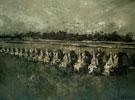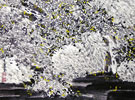Generally speaking, Hoo’s material life in Paris was simple and poor, but she didn’t have high request about material life, only requiring to satisfy the most basic needs in life. During the initial days of learning painting, she could paint for a whole day only with a loaf of bread and a bottle of water.
In 1970, for her outstanding accomplishment in art, the Ministry of Culture in France allocated a studio to her. She used this studio for more than 30 years, and only returned it to the French government when she moved to Shanghai in her late year. Most of her works were created in this medium-sized studio.
All the friends in Paris knew she was warmhearted and eager to help others, and lovingly called her “big sister Hoo”. “Big sister Hoo” was a leftist in ideology, full of sympathy for people in the bottom of the society, and lots of her works presented the life of bottom class. Under her paintbrush, though those nobodies in the bottom of the society lived hard and humble lives, they had a sort of moving perseverance and dignity.
In the 1980s, the mainland China started to reform and open to the outside. Though staying in faraway France, Hoo very much cared about the changes in her mother land, and was also invited to go back home to visit and inspect. She was sincerely happy for her country's development. Then the cultural communications between China and the outside also increased, many people from the domestic art circles often visited this affable “big sister Hoo” when studying or visiting in Paris, and admired those outstanding paintings in her studio, experiencing a long-lost feeling of pure artistic charisma without the interference of ideology. In the middle of the 1990s, Shen Roujian, the chairman of Shanghai Branch of Chinese Artists Association at that time, saw Hoo’s paintings in Paris, liked them very much, and then invited her to hold a solo exhibition in China. In 1996, Hoo Mojong’s Painting Exhibition opened in Shanghai Art Museum, the domestic painters and Shanghai audience saw the works of this outstanding Chinese painter in France for the first time, and through this exhibition the painter herself also truly felt the acknowledgement and affirmation from her fellowmen, which stirred up extraordinary feelings in this person always residing overseas and stimulated her idea of returning home. Also after this solo exhibition, she began the life of flying between Paris and Shanghai. Until 2002, because of senility and the inconvenience of traveling, she thoroughly ended the life in Paris, and formally settled down in Shanghai.
The 37 years in Paris is the most important phase in Hoo’s art career, and her painting style including the formation of art individuality is closely connected with this phase. We may put it in this way, those unforgettable days of striving in Paris resulted in today’s master.
In 2002, Hoo held another large-scale solo exhibition in Shanghai Art Museum in its new address, exhibiting those masterpieces brought from Paris, including 60 pieces of representative oil paintings, prints and sketches. After the exhibition, she generously donated those works to Shanghai Art Museum as its permanent collection. That exhibition was a great success, obtaining comprehensive attention from the domestic art circles. With the pleasant surprise of rediscovering a figure of art history, people appreciated and studied her paintings. In 2007, her solo exhibition was held in the National Art Museum of China again, stirring up new responses in the art circle in Beijing. In that exhibition’s opening ceremony, new and old friends happily gathered together, highly commended and affirmed her works. Nowadays, her works not only often appear in many exhibitions held in art museums and institutes, but also appear in various art media and auctions’ exhibitions. At the beginning of 2011, Shanghai Art Museum will hold a large-scale solo exhibition of retrospect for her once again. To express our gratitude for her contribution to the museum’s non-beneficial collection, our museum especially made a bronze plate of acknowledgement on the wall at the museum’s entrance, which is a special honor for few artists having made great contributions to the museum.
Facing all these honors and activities, Hoo in her eighties is happy but also calm. If the situation of her health is alright, she is contented and happy just to sit quietly in her living-room/studio and continue to create on canvas or paper in her habitual way. When chatting with her, I ask her to take good care of her health and not to work too hard in her senile age, however, she always answers me, “If I don’t paint, I would feel bored, and then will fall sick”, “I have many things to do, and also many ideas about paintings.”
II. Painting’s Style and Features
Nowadays, the existing earliest works created by Hoo are some paintings of figures and still lives created in the middle and later stages of the 1950s. These are paintings with a style between the representational and the expressionistic, rich and heavy colors, simple and unrestrained brushstrokes, and the solid and concise molding, already revealing the painter’s extraordinary talent and temperament. Though the style is apparently different from that of the works created during her stay in Paris, these works of her earliest stage undoubtedly better reflect a certain unsophisticated and innocent value of her painting’s nature, and this nature gradually became gentle and mellow and eventually shone with unique, understated and profound brilliance through refinement and accumulation during the following years in Paris.
Among the works created in the 1960s, the most representative ones are definitely the Doll Series, and Hoo continued creating on this theme for almost one decade. As for the works of this series, I always have the faint feeling that they seem to conceal the painter’s gentlest and saddest inner soliloquy. In terms of style, Doll series is completely expressionistic. Though figures are the main roles in the picture, they show no facial features and have no detailed depiction, only some silhouettes consisting of pure and heavy color fields. They are lonely, or leaning close to each other; some are adults, and some are children; there is a strong intimate feeling permeating inside, but also implying a little bitterness and melancholy. Why did the painter name them “dolls”? Was it because almost all these figures only had two-dimensional and blurry silhouettes and didn’t impress us like real people in life? However, from these figures without facial features or expressions, I truly perceive a profound and weird feeling arising from life, a feeling full of paradoxes, not only showing strong affection, but also revealing helpless sentiment and inner desolation.
Once such a feeling weakened or disappeared, Doll Series developed into a quite decorative style on account of its uniquity consisting of color and form, such as A Man Holding a Guitar and A Man Holding a Pumpkin from the Doll Series at the beginning of the 1970s.
Among all her works, Doll Series created at the end of the 1960s and the beginning of the 1970s are really peculiar and prominent. This series not only is unique and representative in her art career, but also occupies a quite eye-catching position in the modern art history with the strong modernity and visual images of individual psychological colors.
In other figure paintings, Hoo gave them identities in real life. They were the painter’s most familiar people whom she paid most attention to, most of them were common laborers living in the bottom class of the society, and surely the painter herself often appeared in the pictures. Different from the Doll Series, the painter completely applied the realistic means to present them. Though the figures were also simple and concise, the molding was strict, solid and forceful. The colors were still rich and strong, however the color tunes became exquisite and gentle, and the details could stand careful appreciation. The painter never paid much attention to the figures’ expressions, and what she was really interested were the figures’ actions, and the poses and equilibrium consisting of these actions, therefore she often preferred to represent the figure’s back instead of the front, sometimes even a part of the body.










